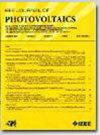Electric Orbit Raising Radiation-Induced Coverglass Darkening and Its Impact on III-V Multijunction Solar Cell Performance
IF 2.6
3区 工程技术
Q3 ENERGY & FUELS
引用次数: 0
Abstract
Electric orbit raising (EOR) radiation-induced coverglass (CG) damage reduces the amount of light that reaches underlying solar cells and decreases photoconversion efficiency. This article describes the modeling, simulation, and ground-based radiation tests using Qioptiq CMG borosilicate CG for five selected EOR trajectories, and the impact on the performance of III-V multijunction (MJ) solar cells. The CG optical transmission loss reaches a maximum of ∼20% around 350 nm. However, the spectral response of the MJ solar cells at this wavelength is minimal. The test results show a darkening related to solar cell performance degradation of up to 5% for the worst-case EOR trajectory.电轨道提升辐射诱发的盖板玻璃暗化及其对 III-V 多接面太阳能电池性能的影响
电轨道提升(EOR)辐射引起的盖玻片(CG)损坏会减少到达底层太阳能电池的光量并降低光电转换效率。本文介绍了针对五种选定的 EOR 轨道使用 Qioptiq CMG 硼硅酸盐 CG 进行的建模、模拟和地面辐射测试,以及对 III-V 多结 (MJ) 太阳能电池性能的影响。CG 的光学传输损耗在 350 nm 左右达到最大值 ∼ 20%。然而,MJ 太阳能电池在这一波长的光谱响应很小。测试结果表明,在最坏的 EOR 轨迹下,与太阳能电池性能下降有关的暗化可达 5%。
本文章由计算机程序翻译,如有差异,请以英文原文为准。
求助全文
约1分钟内获得全文
求助全文
来源期刊

IEEE Journal of Photovoltaics
ENERGY & FUELS-MATERIALS SCIENCE, MULTIDISCIPLINARY
CiteScore
7.00
自引率
10.00%
发文量
206
期刊介绍:
The IEEE Journal of Photovoltaics is a peer-reviewed, archival publication reporting original and significant research results that advance the field of photovoltaics (PV). The PV field is diverse in its science base ranging from semiconductor and PV device physics to optics and the materials sciences. The journal publishes articles that connect this science base to PV science and technology. The intent is to publish original research results that are of primary interest to the photovoltaic specialist. The scope of the IEEE J. Photovoltaics incorporates: fundamentals and new concepts of PV conversion, including those based on nanostructured materials, low-dimensional physics, multiple charge generation, up/down converters, thermophotovoltaics, hot-carrier effects, plasmonics, metamorphic materials, luminescent concentrators, and rectennas; Si-based PV, including new cell designs, crystalline and non-crystalline Si, passivation, characterization and Si crystal growth; polycrystalline, amorphous and crystalline thin-film solar cell materials, including PV structures and solar cells based on II-VI, chalcopyrite, Si and other thin film absorbers; III-V PV materials, heterostructures, multijunction devices and concentrator PV; optics for light trapping, reflection control and concentration; organic PV including polymer, hybrid and dye sensitized solar cells; space PV including cell materials and PV devices, defects and reliability, environmental effects and protective materials; PV modeling and characterization methods; and other aspects of PV, including modules, power conditioning, inverters, balance-of-systems components, monitoring, analyses and simulations, and supporting PV module standards and measurements. Tutorial and review papers on these subjects are also published and occasionally special issues are published to treat particular areas in more depth and breadth.
 求助内容:
求助内容: 应助结果提醒方式:
应助结果提醒方式:


